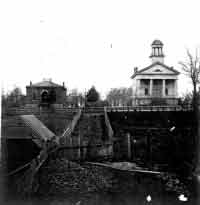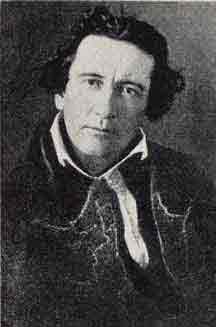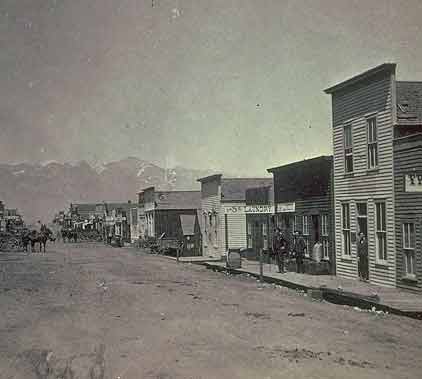It should be remembered that each
of the contestants in the Chess Congress held an established reputation worthy
enough to recommend him as one of the best America had produced. Hiram Kennicott
was elected as of the four vice-presidents of the Congress. In the tournament
itself, he lost in the first round to Benjamin Raphael. In
their closely-contested 6 game mini-match, Kennicott won the 1st and
4th games; Raphael won the 2nd, 5th and 6th
games. The 3rd game was drawn.
There's not a lot known about Hiram
Kennicott himself.
He was born around 1810 in Albion,
New York and had 13 brothers and sisters, many of whom became prominent lawyers
or physicians. In the early 1830's his entire family moved piecemeal to
Illinois. Hiram himself moved to Illinois in 1834. He settled in Vernon Township
of Lake County (so named because the original settlers - Captain Daniel Wright
and his family - came from Mt. Vernon) where he built a cabin on the Des Plaines
River. Vernon Township was close to the towns of Libertyville and Half Day.
Kennicott built a saw mill and grist mill by the Luther Bridge on the Des
Plaines River at a place later known as Vincent's mills and opened stores
eventually in both Libertyville and Half Day.
"The first stock of Goods [General
store] ever opened in Lake County was opened at this place by Hiram Kennicott in
June 1836, in a building which stood near the present site of the District
School house."
[Historical and Statistical Sketches of Lake County, State of Illinois,
by Elijah M. Haines, 1852.]
 Hiram
Kennicott had studied law before migrating west. Because of his training, he
became the first Justice of the Peace in Lake County. In that capacity, he
performed the first wedding in 1834, that of Capt. Wright's daughter, Carolina,
to William Wigham, another pioneer of the county who owned a vast farm.
Hiram
Kennicott had studied law before migrating west. Because of his training, he
became the first Justice of the Peace in Lake County. In that capacity, he
performed the first wedding in 1834, that of Capt. Wright's daughter, Carolina,
to William Wigham, another pioneer of the county who owned a vast farm.
Kennicott's hard work paid off and
by the late 1830's he owned a huge 1000 acre, 200 cow dairy farm at
Elmhurst and Willow Roads. He captured the Chicago market where he sent his milk
and butter. One report says he lived in "Grand Style" with his mansion, named
The Folly along with servants as well as tutors and governesses for
his children.
The
first courthouse
destroyed by a fire in 1875
John Kennicott

By 1836 his parents and several younger siblings moved to Illinois from
New York. Over the course of the years Hiram and his wife produced a dozen
children. His older brother, John, had already moved there at some point between
1832 and 1836. John started off as a teacher, earned his medical degree and
became an itinerant doctor. He also became a noted horticulturalist. His Chicago
home, The Grove*,
originally a large cabin, noted "for its view, its rare and beautiful flowers
and its sweeps of fruit trees and berry bushes," eventually evolved into a
manor and then an environmental center called, the Grove National Historic
Site.
William Henry Kennicott, another
brother, became Chicago's first dentist in 1834 when he opened his office at
Eagle's Tavern. The youngest brother, Jonathan, who, although he received a
medical degree, practiced dentistry with him for a while before practicing
medicine. Other brothers included James, an attorney; Levi, a doctor; Alonzo and
Joseph, farmers.
When the financial crash and
depression of 1837 hit, Hiram lost his farm. He moved his family to New Orleans
(ironically, Paul Morphy was born that year in New Orleans) where he stayed
until 1843. He returned to Illinois and acquired 960 acres.
The subscription list to the Book of the First
American Chess Congress gives Hiram Kennicott as being from Chicago (or
perhaps from the Chicago Chess Club). The 1860 census shows him
living in Cook, Illinois.
Silver Cliff 1882

The 1880 census gives his residence
as Ula, Custer county, Colorado. Actually, he lived in Silver Cliff, a
small mining town that sprung up between the Sangre de Cristo Mts. and the Wet
Mts. in 1878 when silver was discovered there. In June of 1880,
5,040
people lived in Silver Cliff making it the state's third largest city - just
behind Denver and Leadville. The 1880 census shows 14 persons in the Kennicott
household with 70 year old Hiram as the patriarch.
One of the residents listed in the
census was Frank Langdon Kennicott. There is a residence listed on the
National Register of Historic Places called the Kennicott Cabin (or the
Comstock Cabin) located at 63161 Hwy 69. It was designed and built by Frank
Langdon Kennicott circa 1850-1874 and significant as an extant example of
settlement architecture. The cabin was the dwelling on the Frank Kennicott
Ranch, a 1020 acre working cattle ranch in the Wet Mountain Valley.

